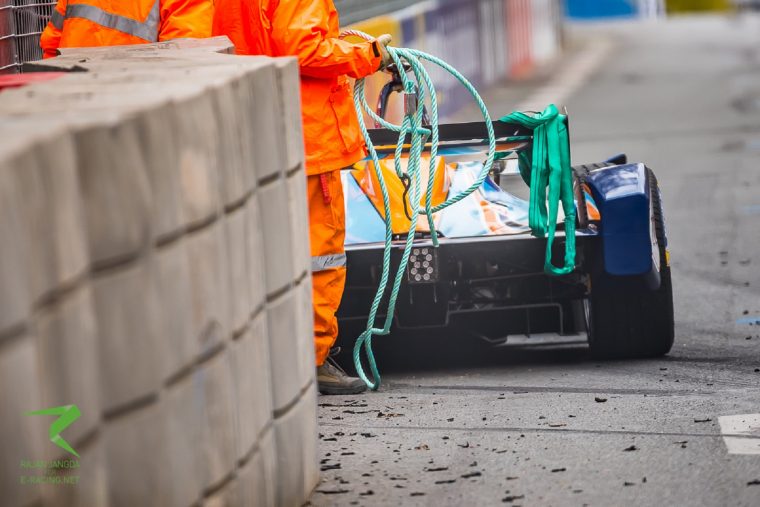Safety in Formula E
[vc_row][vc_column][vc_column_text]
Motorsport is dangerous: these words are plastered everywhere around racing events because the statement is very true. The FIA Formula E Championship, which has seen all-electric racing take to streets all around the world, is no exception.
Dealing with electricity as the power source for a vehicle is high-risk and although we have yet to experience a ‘red car’ scenario within the sport, the chances of the body of the car becoming ‘live’ is a threat that faces the sport every time the cars take to the track.
As season three kick-starts on the streets on Hong Kong in just over two months’ time, we caught up with Consultant Head of Safety at Formula E Holdings and the FIA Formula E Championship, John Trigell.
“I have a dual role [with the sport],” John tells us. “Firstly I look after the safety for Formula E Holdings as a Company. This encompasses all of their legal and moral Health and Safety Corporate responsibilities which would be the same for any UK company, in addition to travel safety, emergency and incident planning.
“For events and races, there is the safety aspect of the set up to look after. This encompasses structures, bridges and gantry builds as well as the track blocks and debris fencing. There are up to 200 plus contractors onsite during this phase and I work with the event managers to ensure this is done without unmanaged risk.
“For the actual races, we ensure all the teams are conforming to the conditions of their FIA E-Licence safety training and ensure all of their equipment is in place. I am also the interface between FE and MDD who provide all of the doctors, paramedics, medical car incident commander and extrication team for the series.”
Having previously worked in Formula One for eight years as a Team Safety Manager to Renault and Lotus, we wanted to know how the safety requirements differ for the two different forms of motorsport.
[pullquote align=”full” cite=”” link=”” color=”” class=”” size=””]“They are pretty much the same. The FIA Sporting regulations and requirements are the same. The difference is that Formula E tracks are predominately street circuits, meaning there is very little in the way of run off. As with all street circuits and the nature of them, there is little room to build in run offs, Monaco is a prime example.”[/pullquote]
As the calendar currently stands for the 2016/17 season, Formula E looks to return to Monaco as well as visiting many new cities around the world. Locations such as Hong Kong, Montreal and New York are all set to host the electrifying championship for the first time in season three. Great news for the cities, but what checks are needed in order for a Formula E race to go ahead?
“With regards to new circuits, the FIA will approve the layout and design, a day or so prior to the race and when the track is completed, the FIA/Race Director and FE Sporting Manager will inspect the track to ensure all of the requirements have been satisfied and the track conforms. On race day, the race director will give the track a final inspection. Weather conditions are also taken into consideration.”
As well as safety on track, the safety of the drivers is also hugely important. With talks of a halo being introduced in Formula One as soon as 2018, many Formula E fans are curious as to whether we will see the introduction of cockpit protection in the sport.
“That is a difficult one to answer,” John tells me. “We will have to wait and see.
“It could apply to any modern day open cockpit motor racing, plus the design of the Formula E cars are likely to evolve considerably over the next few years. It will also depend on what the FIA recommend.”
Being such a new and evolving motorsport series, changes are always being made to make the racing safer both for spectators, but drivers and team personnel too. As expected, when we asked John about the depth of work done revolving around safety before the launch of season one he said there had been an “awful lot” of it.
[pullquote align=”right” cite=”” link=”” color=”” class=”” size=””]“The cars are subject to FIA crash tests, with the teams actually going through more training than F1 teams with regards to safety.”[/pullquote]
“There was an FIA global safety committee to ensure all aspects of safety were looked at and researched,” he goes on.
“All the team members have to complete an initial four day E-safety course which includes an advanced First Aid Certification and then an annual refresher course. In addition, the doctors, paramedics and track rescue team are taken with the series to all races, practicing on-track scenarios at every race. So it’s more a case of honing these skills.”
Ahead of last season a ‘full course yellow’ and revised penalties were put into place, however at the moment John tells us there are no safety changes being made for the start of the new season.
“Like most motor racing series, things may rear their head during the season and new, revised or amended regulations may be required to deal with those situations.”
[/vc_column_text][/vc_column][/vc_row][vc_row][vc_column][vc_column_text]
Image courtesy of Rajan Jangda
[/vc_column_text][/vc_column][/vc_row]





 No part of this website or any of its contents may be reproduced, copied, modified, adapted, used or distributed without the prior written consent of the author. e-racing.net is not responsible for the content of external sites or links.
No part of this website or any of its contents may be reproduced, copied, modified, adapted, used or distributed without the prior written consent of the author. e-racing.net is not responsible for the content of external sites or links.